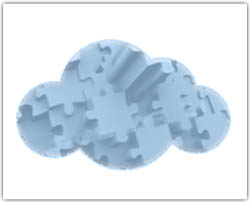September 6, 2011 | Uncategorized
The cost of moving to the cloud is one of the top considerations for organizations looking to include cloud as part of their IT planning. In the past, when the cloud was still a new idea, most people were happy to point out the cost savings that most enterprises would realize from moving to the cloud. Since ROI was generally realized within six months for server virtualization, the Physical-to-Virtual (P2V) migration has, in general, been seen as a win-win situation whenever costs was discussed. But this budgeting view is somewhat limited. Organizations need to look beyond virtualization when considering cloud computing costs and estimated costs savings.
The results of a recent report by Forrester Research show that many IT organizations are seeing a slowing in virtual migrations because of unexpected costs or lower return due to misallocation. Most of these unexpected costs are because IT Management can sometimes avoid reporting specific costs of virtualization when presenting budgets.
Tracking the Details
Although 64 percent of IT Management did believe that virtualization costs needed to be shown in detail including tracking and analysis, 48% admitted that they submitted those costs as a single line item in their budgets. An inability to measure these costs or not having the knowledge in how to track them was the biggest reason given for not providing details.
Most of this problem stems from the fact that traditionally very few companies require IT Departments to supply chargeback to track costs for their department. To determine a cost on a specific item such as virtualization is just not part of the culture or expected in most IT budgets.
Data Storage
In addition, the cost of moving and storing data is often overlooked in the overall cost of moving to the cloud. Most companies do not even consider the initial amount of data that they may move to the cloud, let alone what that data will be five years from now. Network bandwidth is crucial to the workload in the cloud, and needs to be taken into consideration when budgeting cloud expenses.
Multiple Application Vendors
For some, the cost of integrating the apps from various vendors brings an unexpected problem when looking at moving to the cloud. It may mean taking smaller steps into that migration as these vendors develop their own methods of integration. If a company uses Microsoft for email and Cisco for voicemail, as an example, they may want to keep those applications and they find that certain applications are not compatible in the cloud. Time and money can be spent excessively unless this is explored thoroughly at the first stages of migration.
Testing for the Cloud
Migration also includes the cost of testing software to see if it is ready for the cloud. If your system has a large application that is crucial to your business and it has never been tested for the cloud, time and money can be spent debugging to make it ready. A good example is New York’s Marist College who needed to move their large-scale ERP system to the cloud. The problem was that the servers were not yet approved by the vendor. Although the vast majority of the migration went smoothly, there were challenges. As CIO Bill Thirsk put it, “Stabilizing the system within a cloud that already supported 900 virtualized servers gave us quite a challenge. It was a matter of changing some code, which took some time and effort to figure out exactly which lines needed to be changed.”
New Costs for IT – Rent and Utilities
If you are moving from an in-house set of servers to the cloud, you may not be thinking of these kinds of costs in your budget. IT Departments budgets may not, generally, even have line items for rent and utility costs. The bottom line may still mean that costs are being saved; it is just that these costs are generally in a different department, so the introduction of these hard costs needs to be considered. These are not often costs that will show up in your estimates, but the costs are part of the price of doing business in the cloud. It needs to change from a thought process of lump investments in hardware to a monthly fee for services, that include such things as rent and utilities.
One Time Fees
Setup costs, pilot programs, these are all elements of the migration costs that are not part of the ongoing costs, but still need to be considered as part of the overall budget. Many IT Departments look primarily at the ongoing service costs, and forget that there are setup fees to take into consideration. Pilot programs can be costly if contract terms and minimum discounts are not agreed upon prior to trying any pilot program. All too often the turnover from pilot to implementation happens much more quickly than anticipated, leading to unexpected costs in the process.
In general, with the cloud still so new there is a lot that many companies have to learn when evaluating just which cloud services work for them. Both benefits and costs need to be considered, with an eye on the reality that an immature industry brings change that is both exciting and difficult at the same time; opportunities and challenges abound, sometimes with big payoffs.
Gartner Research Vice President Frank Ridder summed it up succinctly when he noted, “Organizations need to understand these changes and develop realistic cloud sourcing strategies and contracts that can reduce risk.” He continues to emphasize that companies need to keep in mind the services sourcing cycle that includes four main drivers: sourcing strategy, vendor selection, contracting and management and governance. That life cycle will remain an important and critical arena for planning and managing resources.
Get started today on outsourcing your infrastructure to the cloud by taking advantage of GMO Cloud America’s $150 hosting credit.
Our newsletters and blogs are written to provide you with tools and information to meet your IT and cloud solution needs. We invite you to engage in our online community by following us on Twitter @GMOCloud and ‘Liking’ us on Facebook.






